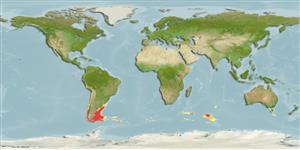Common names from other countries
Classification / Names / Names
Namen | Synonyme | Catalog of Fishes (gen., sp.) | ITIS | CoL | WoRMS
Environment: milieu / climate zone / depth range / distribution range
Ökologie
Pelagisch. Temperate; 0°N - 90°S, 180°W - 180°E
Indian Ocean, Southeast Pacific, and Southwest Atlantic: Cephalorhynchus commersonii commersonii: Falkland Islands, Argentina, South Shetland Islands, Chile.
Length at first maturity / Size / Gewicht / Alter
Maturity: Lm ? range ? - ? cm Max length : 175 cm TL Männchen/unbestimmt; (Ref. 1394); max. veröff. Gewicht: 86.0 kg (Ref. 1394)
Found in relatively shallow coastal waters, but move slightly offshore during winter. Feeds on various sepcies of fish, squid and shrimp, near the bottom (Ref. 1394). Found in relatively shallow coastal waters, but move slightly offshore during winter. Feeds on various species of fish, squid and shrimp, near the bottom (Ref. 1394).
Jefferson, T.A., S. Leatherwood and M.A. Webber. 1993. (Ref. 1394)
IUCN Rote Liste Status (Ref. 130435)
CITES Status (Ref. 108899)
Nutzung durch Menschen
Fischereien: kommerziell
FAO - Fischereien: landings, Artbeschreibung | FishSource | Sea Around Us
Tools
Mehr Information
NamenSynonymeRäuberFortpflanzungGeschlechtsreifeAblaichenFecundityEierEientwicklung
Alter/GrößeWachstumLänge-GewichtLänge-LängeMorphologieLarvenDichte
Internet Quellen
Estimates based on models
Preferred temperature
(Ref.
115969): 6.4 - 13.3, mean 9.4 (based on 356 cells).
Verwundbarkeit
Very high vulnerability (90 of 100).
Preiskategorie
Unknown.
